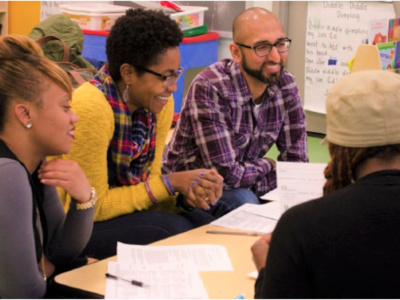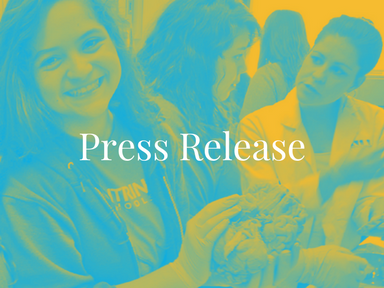Learning from Discomfort in Education: Balancing Safety and Growth
Topics

When educators design and create new schools, and live next gen learning themselves, they take the lead in growing next gen learning across the nation. Other educators don’t simply follow and adopt; next gen learning depends on personal and community agency—the will to own the change, fueled by the desire to learn from and with others. Networks and policy play important roles in enabling grassroots approaches to change.
Discomfort is a necessary part of growth, but it cannot be productive without a foundation of safety and a path toward peace.
Discomfort is defined as a feeling of unease and conflict between our perceptions (what should be) and the realities (what is) of a situation. It may involve wrestling with unpleasant realities and experiencing feelings of friction and disequilibrium. Discomfort is also often touted as a catalyst for growth, a necessary space where transformation takes place. However, as we explored in a recent conversation, discomfort does not exist in isolation. It is complex and intertwined with diverse feelings including safety (or not), tension, division, and peace. Our discussion of discomfort revealed a critical need to deconstruct discomfort to build awareness of these entanglements and work to address the elements present.
The Role of Safety in Growth
When we think about personal development, it’s easy to focus solely on pushing ourselves outside of our comfort zones. However, what happens when discomfort is not a temporary state but a persistent condition? For most of us, we have moved through an experience that left an imprint on us. Whether it’s been a specific trauma, or an experience that left us without a choice, sensations felt as discomfort can be an edge to lean into or an invitation for growth rather than a barrier to it. Moreover, the extent of the barriers can, perhaps, be calibrated by the concentrations of safety and tensions within personal discomfort. In other words, if the discomfort is truly about a disequilibrium we experience when learning something new, it may be temporary and manageable. If the discomfort is grounded in a person not feeling safe, being unhoused, experiencing physical harm, or something else, discomfort is a much more significant barrier.
Peace does not mean the absence of discomfort, but rather, the ability to navigate discomfort from a place of stability.
Safety is foundational. Without it, the nervous system remains on high alert, preventing individuals from reaping the benefits of discomfort. This is especially relevant in the context of childhood development and learning environments. If a child does not feel safe—emotionally, physically, or psychologically—their ability to learn and grow is compromised. The same can be true for adults.
Privilege and the Experience of Discomfort
One of the most thought-provoking aspects of our discussion was the recognition that experiencing discomfort without feeling unsafe is a privilege. Many individuals navigate life with a sense of security that allows them to take risks, whereas others must constantly assess their surroundings to ensure their survival. Acknowledging this distinction is essential when discussing discomfort as a tool for growth.
Reframing Comfort: Seeking Peace Instead
An interesting shift occurred during our conversation: a collective re-evaluation of the word “comfort.” Comfort, in many ways, can be an illusion or even a privilege. It suggests a level of ease that not everyone can access. Instead of striving for comfort, we considered the idea of seeking peace—a state that allows for both security and growth. Our ability to find security and growth hinges on our ability to feel a sense of agency or control in situations. It is important to acknowledge that there are communities and identities who do not have this sense of control. Belonging and comfort require having meaningful voice, mutual power, access, and opportunity for shared design in different containers we collectively occupy.
Peace does not mean the absence of discomfort, but rather, the ability to navigate discomfort from a place of stability. It is a state of being that allows us to remain grounded even when facing challenges. In this way, peace and discomfort can coexist, offering opportunities for resilience and transformation.
Practical Strategies for Navigating Discomfort
Our conversation also touched on ways to cultivate safety and peace while embracing discomfort as a learning tool. Some strategies included:
- Creating Containers of Trust and Safety: Whether in personal relationships, classrooms, or workplaces, establishing spaces where people feel seen, respected, and valued fosters an environment where discomfort can be productive rather than harmful.
- Embodiment: Breathing exercises and calling attention to our breath may help regulate our nervous system, making it more accessible to navigate moments of discomfort.
- Self-Reflection: Asking ourselves questions about where discomfort is arising in our bodies and what it is trying to teach us can shift our perspective from resistance to curiosity.
- Physical Awareness and Grounding: Placing a hand on the heart or belly, stretching, or shifting posture can help create a sense of stability in uncertain moments.
Collective Responsibility in Fostering Safety
An essential takeaway from our discussion was that safety is not solely an individual endeavor—it is a collective responsibility. Whether in personal relationships or professional settings, we must all contribute to environments where others feel safe to grow. This means actively challenging exclusionary behaviors, speaking up when we witness injustice, and fostering spaces where people feel seen and heard.
Safety is not solely an individual endeavor—it is a collective responsibility.
Discomfort is a necessary part of growth, but it cannot be productive without a foundation of safety and a path toward peace. By shifting our focus from mere comfort to a deeper sense of groundedness, we can embrace discomfort in ways that are transformative rather than overwhelming.
As we continue on our respective journeys, perhaps the most important question to ask ourselves is: How can we cultivate peace within and around us so that discomfort becomes a path to growth rather than a source of distress?
Take a moment, close your eyes, and say the word “peace.” Notice what happens in your body. Maybe, just maybe, that’s where the journey begins.
Listen to Our Conversation on Discomfort, Safety, Peace, and Growth
NGLC is grateful for our collaboration and partnership with EDU Café Podcast that brings fresh voices and insights to the blog. Listen to the full episode of the podcast that inspired this article:
Photo at top by Allison Shelley for EDUimages, CC-BY-NC-4.0




